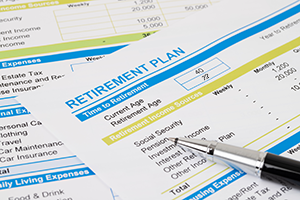Upcoming dates:
March 15
– Due date for partnership and S corporation tax returns (Forms 1065, 1120S)
Reminders
– Daylight savings time begins Sunday, March 12
Recent legislation is taking a broad sweep at retirement accounts. While many of the rule changes are implemented over a number of years, some of them are important to know about right away. Summarized in this issue are some of the more important provisions.
With the pending flow-through filing deadline on March 15th, it is important to understand the nasty late-filing penalty the IRS imposes. So if this impacts you and your side business, review this article.
There are also ideas to help review your homeowner’s insurance policy and a great article outlining tips to think about if you are looking to supplement your income during retirement.
As always, feel free to pass this information on to anyone that may find it useful and call if you have any questions or concerns.
New Tax Rules Mean Changes for Retirement Accounts

The SECURE Act 2.0, passed by Congress in late 2022, features numerous ways for you to save more money in your tax advantaged retirement accounts. Here are several of the bill’s provisions and what they mean for you.
- Money can continue to grow tax deferred. If you turn 72 in 2023 or later, you can keep money in a tax-deferred IRA or 401(k) for another 12 months to help the account continue growing before starting to withdraw funds. This retirement benefit is now available thanks to the required minimum distribution age being raised from age 72 to age 73. The age will increase again from 73 to 75 in 2033.
- Action: Review your retirement account distribution needs and use this extra time to help make your distributions more tax efficient. For example, if you must earn an additional $10,000 before you hit the next highest tax bracket, consider pulling more taxable income out of your retirement account to take advantage of this lower rate. Or use the extra time to consider converting funds tax-efficiently into a Roth IRA.
- Be aware of auto enrollment. The government wants you to save for retirement, so the new law allows businesses to automatically transfer a greater portion of your paycheck into their retirement plan. The maximum contribution that can now be automatically deferred into your employer’s 401(k) plan increases from 10% to 15%.
- Action: While saving more for retirement is a great idea, this automatic participation does not account for your particular financial needs. So be aware of the possibility that you will automatically be contributing to your retirement account and independently determine what you can afford to put towards retirement. Make any adjustments if necessary, as you are permitted to opt out of auto enrollment. Remember, you also need to build an emergency fund and pay your bills!
- Take advantage of higher catch-up limits. Starting in 2024, the $1,000 catch-up contribution for IRAs will receive an annual cost-of-living adjustment in increments of $100, while the $7,500 catch-up contribution for 401(k)s will increase to at least $10,000. This higher 401(k) catch-up limit will also be indexed for inflation starting in 2025. The additional catch-up contribution is available if you’re age 50 or older.
- Action: Review the annual savings limit for your retirement savings account, including the catch-up amount if you are 50 years or older. Then make adjustments to your retirement savings plan as soon as possible to take advantage of the higher savings limits.
Attention Businesses: File on Time or Pay the Price!

March 15th is the tax-filing due date for calendar year S-corporations and partnerships. While this filing deadline does not require making a tax payment, missing the due date could cost you a hefty penalty.
The penalty
The penalty is calculated based on each month the tax return is late multiplied by each shareholder or partner. So a business tax return with no tax due, filed on April 16th, could cost a married couple who jointly own an S-corporation $880 in penalties!*
Take action
Here are some ideas to help you avoid penalties:
- File on time. If you are a partner or shareholder of an S-corporation or partnership, file your company’s tax return on or before March 15th. In addition to the penalties, filing late shortens the time you have to file your individual tax return and pay the taxes due by this year’s April 18th filing deadline.
- Consider an extension. If you cannot file the tax return in time, file an extension on or before March 15th, which gives you an extra six months to file your business return. Remember, you pay the taxes for your flow-through business on your Form 1040 tax return at this year’s April 18th filing deadline.
- Your personal tax return may be delayed. Do not file your Form 1040 tax return until you receive all your K-1s from each of your S-corporation and partnership business activities. But be prepared if your business files an extension, as it’s possible you may need to extend your personal tax return while you wait for the K-1. Remember that an extension to file doesn’t mean an extension to pay your taxes. You may need to estimate how much you’ll owe so you can make a payment by April 18th.
- Challenge the penalty. If your business does get hit with an IRS penalty for filing late, try to see if you can get the penalty abated. This is especially true if you file and pay your personal taxes on time. Kindly remind the U.S. Treasury it is still receiving the taxes owed to them in a timely manner.
If you haven’t filed your S-corporation or partnership return for 2022, there’s still time to get it done or file an extension. Please call if you need assistance.
* The penalty calculation for 2022 S-corporations and partnerships is $220 for each month or part of a month (up to 12 months) the return is late, multiplied by the number of shareholders or partners. So an S-corporation or partnership return filed on April 16th is considered two months late!
Getting the Most Out of Homeowners Insurance

Looking for a way to tackle insomnia? Read your homeowners insurance policy. Kidding aside, it’s worth the effort. This is especially important as insurance costs are going through the roof and too many surprises occur when you need your insurance after an event requires you to file a claim.
Here are some areas that may require a review.
- Setting the correct amount. Just like the three bears fairy tale, you can have too much OR too little insurance. Replacement cost is the key, so review if your policy covers only the mortgage or real-estate value, and not the replacement cost. Construction prices have skyrocketed, so the cost of rebuilding a new home on the same lot could shock you. On the other hand, most claims do not require replacing your entire home.
- Understanding what is NOT covered. Is your home covered for exterior flooding, or only interior water damage? Does the policy include coverage for mold, sewer backup, earthquakes and hurricanes? Nail down the details and pay close attention to local risks. This is where a great insurance agent can help you understand what surprises they have seen with claims. Get an agent that is transparent with this knowledge, as they see both success and horror stories every day.
- Get the right deductibles. You may find that, unlike an auto policy, your homeowner’s insurance doesn’t include a flat-rate deductible for every type of claim. Some policies charge a percentage rate under certain circumstances. Say your house is insured for $300,000 and an earthquake strikes. If the insurer stipulates a deductible of five percent of the policy amount, you may be saddled with $15,000 in out-of-pocket costs before the insurance covers the rest. So explore the correct deductible for your financial situation and understand the policy savings by moving your deductible up or down from its current level.
- Understand liability insurance coverage. A standard homeowners insurance policy usually has some level of liability insurance, albeit often at a minimal level. Ask several professionals what level of liability insurance would make sense for your particular situation and be willing to bump up your coverage to protect you and your family in the event that someone is injured while on your property. Many companies offer umbrella insurance to provide additional coverage for claims against you. Review if this is a good addition for your situation.
With homeowners insurance premiums skyrocketing, now is the time to really understand your coverage and the underlying risks you are absorbing. Remember, our natural tendency is to avoid the small print, but by understanding the natural tendencies of insurance companies to shift more of the burden from them to you, this knowledge can be used to motivate yourself to spend some time reviewing the details.
Tips for Working Beyond Retirement Age

You may be one of many Americans who plan to work into retirement. Some report they need to work because their savings declined over the past several years, while others say they choose to work because of the greater sense of purpose and engagement that working provides.
Whatever your reason for continuing to work into retirement, here are some tips to get the greatest benefit from your efforts.
- Consider delaying Social Security. You can start receiving Social Security retirement benefits as early as age 62, but if you continue to work it may make sense to delay taking it until as late as age 70. This is because your Social Security benefit may be reduced or be subject to income tax due to your other income. In addition, your Social Security monthly benefit increases when you delay starting the retirement benefit. These increases in monthly benefits stop when you reach age 70.
- Pay attention to bracket-bumping. Keep in mind that you may have multiple income streams during retirement that can bump you into a higher tax bracket and make other income taxable if you’re not careful. For example, Social Security benefits are only tax-free if you have less than a certain amount of adjusted gross income ($25,000 for individuals and $32,000 for married filing jointly in 2022), otherwise as much as 85 percent of your benefits can be taxable.
Required distributions from pensions and retirement accounts can also add to your taxable income. Be aware of how close you are to the next tax bracket and adjust your plans accordingly. - Be smart about health care. When you reach age 65, you’ll have the option of making Medicare your primary health insurance. If you continue to work, you may be able to stay on your employer’s health care plan, switch to Medicare, or adopt a two-plan hybrid option that includes Medicare and a supplemental employer care plan.
- Look over each option closely. You may find that you’re giving up important coverage if you switch to Medicare prematurely while you still have the option of sticking with your employer plan.
- Consider your expenses. If you’re reducing your working hours or taking a part-time job, also consider the cost of your extra income stream. Calculate how much it costs to commute and park every day, as well as any other work-related expenses. Now consider how much all those expenses amount to in pre-tax income. Be aware whether the benefits you get from working a little extra are worth the extra financial cost.
- Time to downsize or relocate? Where and how you live can be an important factor determining the kind of work you can do while you’re retired. Downsizing to a smaller residence or moving to a new locale may be a good strategy to pursue a new kind of work and a different lifestyle.
- Focus on your deeper purpose. Use your retirement as an opportunity to find work you enjoy and that adds value to your life. Choose a job that expresses your talents and interests, and that provides a place where your experiences are valued by others.
